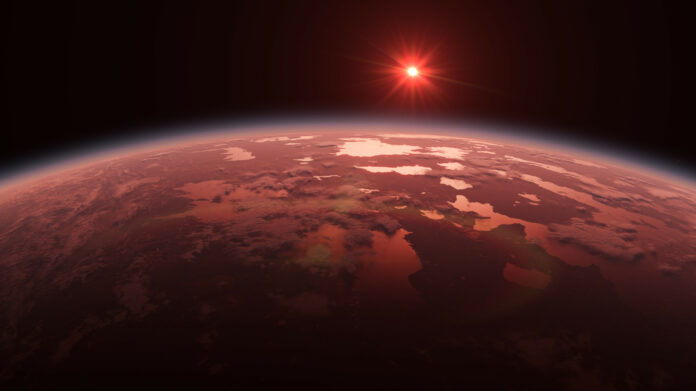A large proportion of the most common type of planet in the galaxy could be situated in the habitable “Goldilocks Zone” of their solar system, research has found.
Astronomers from the University of Florida have found that of the billions of planets orbiting stars smaller and cooler than our own sun—named M-dwarf stars—around one-third of the planets may be orbiting at the right distance and shape that allows for the formation of liquid water on the planet’s surface, also known as the “Goldilocks Zone.”
According to the paper, published in the journal Proceedings of the National Academy of Sciences, this makes these planets a candidate for the existence of life.
ISTOCK / GETTY IMAGES PLUS
“I think this result is really important for the next decade of exoplanet research, because eyes are shifting toward this population of stars,” co-author of the paper and doctoral student at the Univerity of Florida, Sheila Sagear, said in a statement.
“These stars are excellent targets to look for small planets in an orbit where it’s conceivable that water might be liquid and therefore the planet might be habitable.”
Planets orbiting M-dwarf stars, which are stars only around the size of Jupiter, are the most common form of exoplanets, as these dwarf stars themselves are the most frequent in our galaxy.
“Cool red dwarf stars…are the most common type of stars (75 percent of stars in the Milky Way), so if we are looking for life on exoplanets around other stars, these types of stars are of high interest. In fact, our closest star Proxima Centauri is also a red dwarf and also has a planet Proxima Centauri b in the traditional habitable zone—i.e. liquid water,” Laura McKemmish, a quantum chemist and molecular physicist at the University of New South Wales, previously told Newsweek.
Exoplanets are planets orbiting other stars billions of miles away from our planet. There are 5,419 confirmed exoplanets as of May 23, 2023.
The astronomers found that two-thirds of exoplanets orbiting dwarf stars that orbited close enough for habitable levels of warmth orbited too close for the planet’s tidal forces, roasting the planet due to the stretching and squishing of the planet itself by the star’s gravity. This is due to the oval shape of many of these planets’ orbits, which can increase the effects of tidal heating.
“It’s only for these small stars that the zone of habitability is close enough for these tidal forces to be relevant,” Sarah Ballard, an astronomy professor at the Univerity of Florida, and co-author of the paper said in the statement.
They also found that if there were multiple planets orbiting a star, those planets were more likely to have more circular orbits and therefore be less prone to tidal heating and better suited to life. Single-planet stars were therefore more commonly orbited in oval-shaped paths, heating the planets.
In the paper, the authors describe how they studied 150 of the planets orbiting the dwarf stars using data from NASA’s Kepler telescope, analyzing the orbits of the planets by observing them as they pass in front of their stars.

ISTOCK / GETTY IMAGES PLUS
“There’s many methods to detecting exoplanets,” Néstor Espinoza, an astrophysicist and astronomer at the Space Telescope Science Institute (STScI) in Baltimore, told Newsweek in March.
“The most popular one, though, is the method of Transiting Exoplanet detection, in which we simply wait patiently until the planet passes in front of the stars. And if we’re lucky enough, that transit happens in the same line of sight that we’re looking from Earth, then we observe a little dimming of the flux that we observed from that star,” he said.
The paper also uses new data on the distances of the Earth from billions of stars across the galaxy, collected by the Gaia telescope.
“The distance is really the key piece of information we were missing before that allows us to do this analysis now,” Sagear said.
The fact that one-third of the planets around dwarf stars could be habitable places a vast number of exoplanets in the firing line for analysis and study. However, there are still issues surrounding planets orbiting dwarf stars that might limit the ability of life to evolve.
“But red dwarf stars are much more volatile than hotter stars like our sun and experience a much higher rate of stellar flares,” McKemmish said. “These stellar flares and associated coronal mass ejections emit deadly radiation and so the habitability of planets around red dwarfs is highly uncertain because it is expected these frequent and strong stellar flares would destroy the habitability of the planet (e.g. unstable atmospheric composition, radiation destroying life molecules once it gets through the atmosphere, etc).”
Do you have a tip on a science story that Newsweek should be covering? Do you have a question about exoplanets? Let us know via [email protected].


